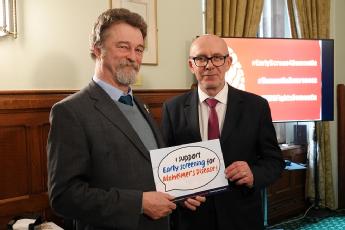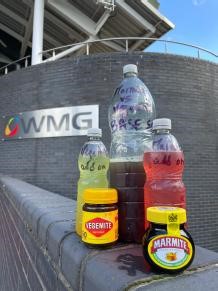Dementia Action Week: WMG calls for volunteers for ground-breaking Alzheimer’s screening tests
Expert comment from Professor Alan Chalmers
For Dementia Action Week, WMG at the University of Warwick, together with Superlunary Labs, are doubling their efforts to develop a low-cost, non-intrusive method for the early screening of Alzheimer’s disease using a simple flavour test which can be undertaken as part of a regular health check-up by a nurse, at a pharmacy or community centre.
The test can help diagnose the beginnings of Alzheimer's years before symptoms of memory loss through a loss of taste or smell.
Scientists at WMG are looking to get data from at least 1000 people before aiming to roll the screening out nationwide, potentially as early as next year. If you want to take part in the trial, and can get to the University of Warwick campus, contact Alan.Chalmers@warwick.ac.uk to be part of the future of medicine.
 Professor Alan Chalmers commented: “Working with MPs and their constituency offices we will be collecting more data across the country to significantly enlarge our dataset of people’s flavour perception ability. This dataset, together with AI and MRI scans, will enable us to validate our screening method. Once validated we will be able to roll out the method widely, hopefully as early as next year.
Professor Alan Chalmers commented: “Working with MPs and their constituency offices we will be collecting more data across the country to significantly enlarge our dataset of people’s flavour perception ability. This dataset, together with AI and MRI scans, will enable us to validate our screening method. Once validated we will be able to roll out the method widely, hopefully as early as next year.
"New drugs that slow disease progression down offer real hope to people living with Alzheimer’s Disease, but crucially the disease needs early diagnosis for these drugs to be most effective. One might have the disease many years before failing a memory test, the current means for diagnosing Alzheimer’s Disease.”
WMG researchers present new Alzheimer’s widespread screening device at parliament
On Wednesday (24th April), WMG at the University of Warwick’s Professor Alan Chalmers, and his research team, held a parliamentary drop-in session, hosted by Sir Jeremy Wright, MP for Kenilworth & Southam and Vice-chair of the all-party parliamentary group on Dementia.
Scientists at WMG, have been working on ground-breaking medical screening for neurodegenerative conditions, with a particular focus on Alzheimer’s disease. The research is based on growing evidence that people suffering with such diseases can lose their sense of smell and taste, many years before other symptoms, such as memory loss, become apparent.
An early diagnosis is critical for those with the disease. New drug technology can slow the progress of Alzheimer’s, but only if detected early enough.
Together with research partners including the NHS, Neurosaliance, and Superlunary Labs, the scientists updated policy makers on the progress of a National Engagement Framework for facilitating screening across the county and demonstrated a new working prototype of their flavour perception testing system.
Matt Western, MP for Leamington and Warwick, said: “We should strive for equality in dementia diagnosis across the UK. It was great to meet Professor Chalmers and his team from WMG. They are working with Superlunary Labs to develop flavour perception technology, for wide-spread non-invasive screening, which could help us achieve that goal.”
The Framework was piloted last year and resulted in data being collected at a number of venues across the country facilitated by MP’s constituency offices.
The plan is for the easy-to-use, low-cost perception testing system to be deployed in pharmacies, care homes and GP surgeries across the country.
This will allow people to measure their own flavour perception ability without the need for a GP appointment. The results will be sent to GPs via a mobile app, and those who perform poorly can then be referred for further tests.
WMG’s Professor Alan Chalmers, who is leading the research said: “In this simple screening test, people are given different flavours to smell and taste. They then, for example, determine which is sweeter, less astringent or smells more of lemon. It’s an easy, non-invasive test which can be rolled out to people quickly right across the UK. It was great to have an opportunity to share our Framework with policy makers.
“At the moment, people who present with symptoms of memory are referred for MRI scans and spinal fluid tests to confirm a diagnosis. By the time memory loss occurs things are often too late; pioneering drug treatments only perform well in the early stages of degeneration. MRI scans and spinal fluid tests are currently not done before there is an indication of the disease as they are incredibly invasive, can cause distress and are expensive and time-consuming for the NHS. Failure of the flavour test can give the necessary early indication.”
Marcus Jones MP for Nuneaton, added: “It was wonderful to meet the team from WMG and Superlunary Labs working to develop flavour perception testing as a method of early screening for neurodegenerative conditions. Work like this is essential for tackling the growing problem of dementia in the UK.”
Read more about WMG’s Visualisation research here: Visualisation Group (warwick.ac.uk)
Warwick’s Wonka explores the world of pure imagination
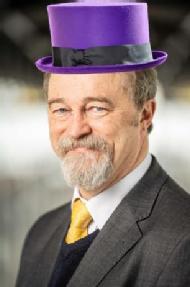 Professor of Visualisation, Alan Chalmers, an expert in flavour simulation at WMG at the University of Warwick, discusses the most famous creations of Willy Wonka ahead of the film premiere this December.
Professor of Visualisation, Alan Chalmers, an expert in flavour simulation at WMG at the University of Warwick, discusses the most famous creations of Willy Wonka ahead of the film premiere this December.
“While we may not have discovered the source of snozzberries, our research invites everyone to wonder about the extraordinary possibilities within the science of flavours” – Professor Chalmers.
Professor Chalmers is the creator of an exciting new flavour experience in a virtual way, with the opportunity to taste almost anything in a sip. The process takes samples of food for analysis, to accurately simulate a real flavour by extracting its tastes, aromas, and mouthfeel. His research has placed him as Warwick’s Willy Wonka.
“We can take a person on a journey through the vast flavour space from the start flavour to a variant that they enjoy”.
Three-course meal bubble-gum:
“Flavour is just the sensation of the taste, aroma and mouthfeel of food or drink in your mouth. If you take the real food or drink and analyse them to extract these components – then they can simply be authentically simulated with UK Food Standards Agency food-safe chemicals.
“So, you take a fork full of roast turkey, gravy, Brussel sprouts and a bit of roast potato … and analyse it with specialist devices to extract exactly what the taste, aroma and mouthfeel components are for this food ensemble. Once you have this “recipe” you simply recreate this exact flavour with the food-safe chemicals – with a specific food-safe chemical for each component, for example, sucrose is used to simulate the sweetness component.
The correct combinations of these chemicals can then be embedded in chewing gum … and voila – as you bite down on the chewing gum – you will experience the same flavour – as if you just had eaten the real roast turkey, gravy, Brussel sprouts and roast potato.”
Lick-able Wallpaper:
“This would be quite straightforward to do. You simply need to embed the food-safe chemicals for each of the components of the desired flavour into the wallpaper – and as it is licked – so the flavour will be perceived.”
The Everlasting-gobstopper:
“I could imagine a ball of eg hard plastic which is impregnated with a sweet flavour. The sweet won’t get smaller - but at some point the sweet flavour will have to be replenished. This will depend how often the gobstopper is sucked and how hard! I could imagine the centre of the plastic ball contains the liquid and this is drawn out as the person sucks. The liquid could be replaced when required.
“Not sure it is a sweet I would want – I think I will stick to chocolate!”
ENDS
Notes to editors
For further information please contact
Bron Mills
bron.mills@warwick.ac.uk
07824540720
The technology was not originally created with inspiration from the infamous chocolatier. The theory behind the invention is that changes in a person's taste and smell senses could be an early indication of Alzheimer’s before signs of memory loss arise. The easy-to-use low-cost dispenser could be used by a nurse as part of an annual health check, in pharmacies, care homes, community centres and even in the home. Researchers hope to achieve UK-wide screening services where members of the public can take a simple smell and taste test. Those who perform poorly can then be referred for further tests which could result in an Alzheimer’s diagnosis.
Professor Chalmers said: “At the moment, people who present with symptoms of memory loss are referred for MRI scans and spinal fluid tests to confirm a diagnosis. By the time memory loss occurs, things are often too late; pioneering drug treatments only perform well in the early stages of degeneration.
University of Warwick scientists create virtual marmite for World Marmite Day – with ground-breaking potential for Alzheimer’s diagnosis
Scientists at WMG at the University of Warwick have produced virtual flavours of marmite and vegemite from scratch, using technology that can replicate the flavour of almost any food or drink and is being used in a new taste test to help with early Alzheimer’s diagnosis.
WMG’s Professor of Visualisation, Alan Chalmers has created the virtual flavours for World Marmite Day (28th September) and can, through taking samples of a food and analysing it, accurately simulate a real flavour by extracting its tastes, aromas, and mouthfeel.
The analysis is done by New-Food Innovation, a high-tech food company. Once analysed the virtual flavours are created to accurately match the real flavour using UK Food Standards Agency approved food-safe chemicals.
The analyses/ investigations are all part of Professor Chalmers’ research, together with West Midlands company Superlunary Labs, into how people perceive taste and smell.
He is also investigating whether a poor performance on the new ‘taste test’ that he has developed, may be an early warning signs for diseases including dementia. This could lead to a much earlier diagnosis of diseases such as Alzheimer’s Disease, well before any memory loss starts to occur.
Professor Chalmers describes the flavour making process as the same as using a recipe – by accurately simulating the different components of a flavour, food such as marmite can be replicated with a taste indistinguishable from the real thing.
He commented: “We recreated the health drink rooibos tea and even the chief taster of a rooibos manufacturer in South Africa could not distinguish between the real and virtual rooibos.
“I first thought of creating the samples of marmite and vegemite for a bit of fun during the Ashes cricket tests this summer as people kept asking - what is the difference between them?
“It goes back to the serious work we’re doing which shows that people’s taste and smell can give us clues what’s going on in a person’s brain years before symptoms such as memory loss start”.
Malcolm Barnes from Superlunary Labs added: “We work alongside Professor Chalmers to ensure virtual flavours are delivered from an easy to use, hygienic and highly calibrated device for Chalmers’ team to analyse.’
The full paper on the technology behind this process can be found here.
Read more about WMG’s Visualisation research here: Visualisation (warwick.ac.uk)
New taste and smell test could diagnose Alzheimer's long before memory loss starts
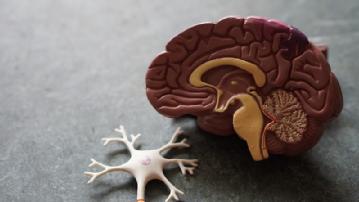
A simple smell and taste test could revolutionise diagnosis of Alzheimer’s – long before symptoms of memory loss even arise.
Scientists are working on a ground-breaking medical screening for the disease which could also improve treatment options. The research is based on growing evidence that people with Alzheimer’s can lose their sense of smell and taste many months or even years before other symptoms, such as memory loss, become apparent.
An early diagnosis is critical for those with the disease. New drug technology can slow, or even reverse the progress of Alzheimer’s, but only if the disease is detected early enough. The drug, lecanemab, is one of two new treatments for the disease.
The research, led by WMG at the University of Warwick together with Superlunary Labs and with support from University Hospitals Coventry & Warwickshire (UHCW) NHS Trust, New-Food innovation, and Alzheimer’s Society, could lead to UK-wide screening services where members of the public can take a simple smell and taste test. Those who perform poorly can then be referred for further tests which could result in an Alzheimer’s diagnosis.
The novel solution provides accurately simulated flavour samples (known as virtual flavour, developed in collaboration with New Food Innovation) via an easy-to-use low-cost dispenser, which could be used by a nurse as part of an annual health check, in pharmacies, care homes, community centres and even in the home.
While in the trial stages at the moment, academics hope that one day an inclusive mobile Alzheimer’s screening unit could reduce significant pressures on the NHS and ease waiting times for those who are struggling to get an appointment with their GPs.
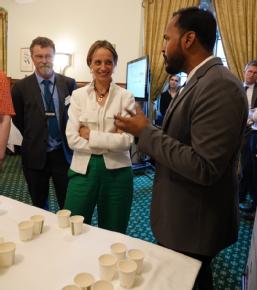 Professor Alan Chalmers from WMG at the University of Warwick said, “In this simple screening test, people will be given different flavours to smell and taste – they then determine which is sweeter, less astringent, smells more of lemon, for example. It’s an easy, non-invasive test which can be rolled out to people quickly across the UK.
Professor Alan Chalmers from WMG at the University of Warwick said, “In this simple screening test, people will be given different flavours to smell and taste – they then determine which is sweeter, less astringent, smells more of lemon, for example. It’s an easy, non-invasive test which can be rolled out to people quickly across the UK.
“At the moment, people who present with symptoms of memory loss are referred for MRI scans and spinal fluid tests to confirm a diagnosis. By the time memory loss occurs things are often too late; pioneering drug treatments only perform well in the early stages of degeneration. MRI scans and spinal fluid tests are currently not done before there is an indication of the disease as they are incredibly invasive, can cause distress and are expensive and time-consuming for the NHS. Failure of the flavour test can give the necessary early indication.
“Our preliminary data shows that there is a difference in the flavour detection of those with Alzheimer’s compared to those without the disease, so we hope to get further backing and implement these screening tests UK-wide.
“It’s important to note that the loss of smell and taste associated with Alzheimer’s is quite different to that of long COVID. While COVID could cause a loss of the sense of taste and smell, long COVID can alter your sense of flavour – a combination of taste, smell and mouthfeel – rather than diminish it.”
This research was showcased by the University of Warwick alongside the Alzheimer’s Society, at an All-Party Parliamentary Group (APPG) on dementia, on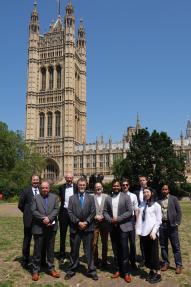 14 June. The APPG is hosted by Sir Jeremy Wright, MP for Kenilworth & Southam and vice-chair of the all-party parliamentary group on Dementia.
14 June. The APPG is hosted by Sir Jeremy Wright, MP for Kenilworth & Southam and vice-chair of the all-party parliamentary group on Dementia.
Sir Jeremy Wright MP added: “I am delighted to be hosting an event at the House of Commons focussing on a development that could contribute to a significant improvement in the mass diagnosis of Alzheimer’s, alongside the new strides in treatments that have been announced in recent months.”
Dr Richard Oakley, Associate Director of Research at Alzheimer’s Society, said: “It’s really exciting to see how researchers are thinking outside of the box about potential methods to detect the diseases that cause dementia at the earliest stages. This is so important now that new disease-modifying treatments are just around the corner.
“The NHS needs to be ready for these new treatments. We can’t be in a situation where new drugs are being approved but people can’t access them early when they work best. Alzheimer’s Society will continue to stand up for people living with dementia and push for more accurate, earlier dementia diagnosis in the NHS.”
Malcolm Barnes, Director of Superlunary Labs added, “Simplicity of the device and test is key to collecting big data across different age groups and demographics.”
WMG Visualisation Engineers use VR to help recreate experience of Medieval Coventry Weaver’s House during Coventry’s year as UK City of Culture
Coventry is not only famed for its Cathedral, two tone music and the automotive industry, it is also famous for its weaving, in fact the medieval Weaver’s House still stands as an attraction today in Coventry’s Spon Street. In 1540 John Croke and his family would have been making cloth on a wooden loom in the Weaver’s House, and whilst you can go to the house, the opportunity to experience the home exactly how it would have been for John and his family is now possible, thanks to visualisation engineering researchers from WMG at the University of Warwick.
House still stands as an attraction today in Coventry’s Spon Street. In 1540 John Croke and his family would have been making cloth on a wooden loom in the Weaver’s House, and whilst you can go to the house, the opportunity to experience the home exactly how it would have been for John and his family is now possible, thanks to visualisation engineering researchers from WMG at the University of Warwick.
Using Virtual Reality WMG's Professor Alan Chalmers (Professor of Visualisation at the International Digital Laboratory, WMG, University of Warwick) and his students have recreated a walkthrough of the medieval Weaver's House in Spon Street, the movement and skill of operating the loom was captured using Microsoft Kinect V2 cameras against a green screen, before being extracted and put onto a screen with a realistic background created. The addition of candles adds to the complexity of the process but makes the scene a more accurate portrayal of the living and working conditions.
It is part of a free exhibition called ‘Metropolis’ just opened at the newly refurbished and renamed Metropolis restaurant in Coventry (formerly Drapers' Bar), an exhibition that explores the story of Coventry through its building. The exhibition is running during Coventry’s year as UK City of Culture.
The exhibition’s curators, Sabine Coady Schäbitz and Mark Webb weave medieval and modern stories together in five themes: movement, enterprise, culture, resilience and the future. It celebrates Coventry’s distinct contribution to the history of the built environment in Britain, from industrial premises including workshops and factories, to major religious buildings containing some of the finest decorative art in the country.
Professor Alan Chalmers, from WMG, University of Warwick comments:
“My team and I are really pleased to be a part of this exhibition and especially to demonstrate our new technology that recreates on screen an authentic portrayal of the skills of medieval weaving, an industry that was so vital to the city’s makers reputation and prosperity in the 16th century.
“We were delighted to be working with charity Medieval Coventry and be funded by the Institute of Engagement's Community Partnership Fund with support and guidance in making the results of our research accessible to the public.”
There are plans to take the exhibit on a tour of local schools in 2022 and produce an extended multisensory display in the Herbert Museum's Medieval Gallery that will include other local skills such as dyeing and tanning.
This isn’t the only contribution the University is making for the exhibition, as after many months exploring the film archives to discover the story of the city's architecture, Film Television Studies PhD student Kat Pearson looks at Coventrians’ relationship with the built environment in her film.
Kat collaborated with The Media Archive for Central England (MACE) on creating a series of short archive films drawing on gems from the MACE collection. Along with Archivist Philip Leach they have brought together items which highlight the relationship between Coventry's communities and its buildings in the latter half of the 20th Century.
PhD researcher Kat Pearson from the Department of Film and Television Studies at the University of Warwick comments:
“This is a topic that I have a personal interest in and researching these films has been an amazing opportunity for me to look at the architecture of Coventry in a new light. The Metropolis exhibition allows us to showcase some wonderful archival films in a public space, and this builds on a project in 2020 to bring archival films to the Foleshill community.”
Further information on Kat's work in Foleshill can be found here: https://warwick.ac.uk/fac/arts/film/tvhistories/blog/foleshillscreenings
Exhibition details:
Metropolis: Coventry’s medieval and modernist ambitions
Free (10am-6pm daily)
1st Floor of Metropolis, Earl Street, Coventry CV1 5QP
For further information please contact:
Peter Dunn, Director of Press and Media Relations:
Mobile: 07767 655860 Email p.j.dunn@warwick.ac.uk
PJD 20th July 2021
VR headsets enable people of all abilities to experience life on-board unique tall ship
People with a range of abilities can use VR headsets to experience what it’s like on board one of the Jubilee Sailing Trust’s ships to encourage them to explore their ability  and participate in a life-changing voyage thanks to an app made by WMG student Tanin Aparimarn at the University of Warwick.
and participate in a life-changing voyage thanks to an app made by WMG student Tanin Aparimarn at the University of Warwick.
The Jubilee Sailing Trust want to encourage more mixed ability people to sail on their fully accessible tall ships, prompting WMG, University of Warwick student Tanin Aparimarn to make a 3D printed version of a ship, a VR experience and an app tour for mixed ability people to experience what it’s like on board.
The VR headset used is a simple cardboard one available to purchase for around £5 online, and enables the user to select an avatar either standing or at wheelchair level to look around the ship as you would in reality, demonstrating what it would be like on board the ship.
An app tour enables the avatar to move around the ship as they would wish, this way the user can experience what it would be like to move around the ship and experience the environment around them beforehand.
Tanin also made a 3D printed, scale version of the tall ship STS LORD NELSON that is 450mm long, complete with three masts and removable decks which allows a visually impaired user to get a tactile sense of where everything is on board.
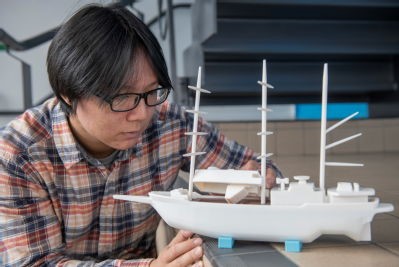 Tanin Aparimarn, from WMG at the University of Warwick comments:
Tanin Aparimarn, from WMG at the University of Warwick comments:
“Using modern technologies such as VR and 3D printing will hopefully encourage more people to take up sailing with the Jubilee Sailing Trust, as now they’ve been able to experience what it would be like on board thanks to the VR experience and the app tour, and they can see what they ship would look like physically because of the 3D printed model.
“I hope that in the future all sorts of tourist destinations and attractions can use VR to encourage people to visit them, as VR offers a more interactive experience than looking at photos.”
Andy Spark, Head of Programmes from the Jubilee Sailing Trust comments:
“Tanin’s work is great. Many people with disabilities need to know that the accessibility on board our tall ships is suitable for their needs any and generally it’s not expected a large sailing ship would be!
“However, the JST is unique as it has two purpose designed and built tall ships to allow people of all abilities (including wheelchair users) to be able to sail on equal terms. The VR tours and the tactile model of the ship Tanin has created will greatly assist the JST to showcase its vessels to those that can gain so much from a voyage experience with us.”
ENDS
21 MAY 2019
NOTES TO EDITORS
High-res images available, credited to the University of Warwick, at:
https://warwick.ac.uk/services/communications/medialibrary/images/may2019/ship_15.jpg
https://warwick.ac.uk/services/communications/medialibrary/images/may2019/ts_1.jpg
https://warwick.ac.uk/services/communications/medialibrary/images/may2019/ts2.jpg
https://warwick.ac.uk/services/communications/medialibrary/images/may2019/ship_10.jpg
https://warwick.ac.uk/services/communications/medialibrary/images/may2019/ship_07.jpg
About WMG
WMG is a world leading research and education group and an academic department of the University of Warwick, established by Professor Lord Kumar Bhattacharyya in 1980 in order to reinvigorate UK manufacturing through the application of cutting edge research and effective knowledge transfer.
WMG has pioneered an international model for working with industry, commerce and public sectors and holds a unique position between academia and industry. The Group’s strength is to provide companies with the opportunity to gain a competitive edge by understanding a company’s strategy and working in partnership with them to create, through multidisciplinary research, ground-breaking products, processes and services.
Every year WMG provides education and training to schoolchildren through to senior executives. There is a growing part-time undergraduate programme for apprentices, as well as full-time undergraduates. The postgraduate programmes have over 2,000 students, in the UK and through centres in China, Singapore, Thailand, Malaysia and Cyprus
For more information visit www.wmg.warwick.ac.uk
About Jubilee Sailing Trust
The Jubilee Sailing Trust (JST) is a registered charity whose mission is to promote the integration of people of all abilities through the challenge and adventure of tall ship sailing aboard two very special ships, Lord Nelson and Tenacious. We have a unique mission, to give people of mixed abilities and circumstances the freedom to explore their ability, potential and place in the world through inclusive adventures at sea.
For more information visit www.jst.org.uk
For further information please contact:
Alice Scott
Media Relations Manager – Science
University of Warwick
Tel: +44 (0) 2476 574 255 or +44 (0) 7920 531 221
E-mail: alice.j.scott@warwick.ac.uk
The sky’s the limit for one of WMG’s doctoral graduates
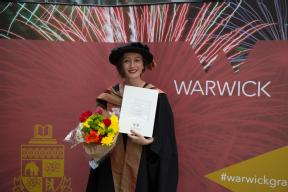
WMG doctoral graduate, Pinar Satilmis has received a Faculty of Science Doctoral Thesis Award for her PhD project “High Fidelity Sky Models”.
Pinar’s thesis, “High Fidelity Sky Models” involved investigating innovative ways to simulate light, to accurately replicate real world lighting and cloud illumination in virtual environments. Pinar investigated a number of different methods including generating animated virtual environments to model changes in skylight in real time and using machine learning to predict light values.
Scene-Referred: next generation video to be unveiled at IBC Amsterdam
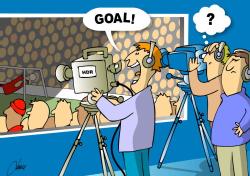 The next generation of “Scene-Referred” High Dynamic Range (SR-HDR) video, developed by a European consortium led by WMG at the University of Warwick, will be demonstrated publicly for the first time at this year’s International Broadcasting Convention (IBC)Link opens in a new window in Amsterdam.
The next generation of “Scene-Referred” High Dynamic Range (SR-HDR) video, developed by a European consortium led by WMG at the University of Warwick, will be demonstrated publicly for the first time at this year’s International Broadcasting Convention (IBC)Link opens in a new window in Amsterdam.
Researchers who have seen this technology in the lab claim that SR-HDR represents the biggest step forward since the emergence of colour and is the ultimate destination for the first examples of HDR which are currently emerging on the consumer market.
“Scene-Referred” means the full range of lighting in a scene is captured and preserved via a future-proof SR-HDR codec. The system also includes a real-time production system and a unique 10,000nit HDR display.
This display is 10 times brighter than currently available HDR displays and it’s the first time a 10,000nit display has ever been shown publicly. Such a display ensures that the picture can be fully appreciated without the need for a darkened room.
WMG Professor Recognised for Pioneering Work and Life-Long Contribution to Digital Cultural Heritage
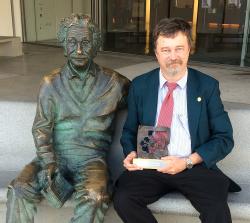 Professor Alan ChalmersLink opens in a new window has been awarded a prestigious Tartessos Award from the Spanish Society of Virtual Archaeology for his ‘pioneering work and life-long contribution to the field of Digital Cultural Heritage’.
Professor Alan ChalmersLink opens in a new window has been awarded a prestigious Tartessos Award from the Spanish Society of Virtual Archaeology for his ‘pioneering work and life-long contribution to the field of Digital Cultural Heritage’.
The Spanish Society of Virtual Archaeology is a non-profit scientific association with the aim of combining all professionals from different disciplinary areas related to archaeology, cultural heritage and new technologies.
Professor Chalmers was presented with the award at the Digital Heritage 2015 international conference in Grenada last year.

